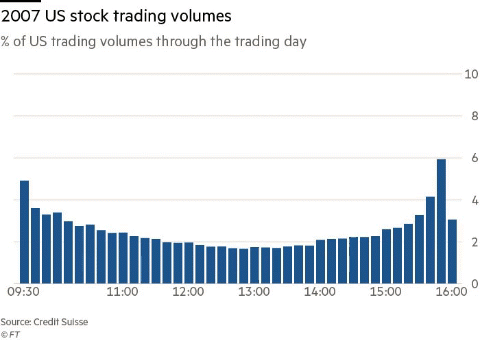
Trading volatility has been re-emerging with a vengeance across capital markets, and the industry press has taken note.
Most recently, Robin Wigglesworth of the Financial Times has been releasing a series of articles and Tweets on the subject, highlighting some key shifts in trading drivers and practices as well as some emerging risks to overall stability in the markets. You can read the whole article on the Financial Times site (subscription required) — I’ll simply highlight a few key points.
In the QA and failure analysis world, people talk about “bathtub curves,” while traders refer to something more akin to a smile. Trading volumes typically peak at market open, and again near market close, while the middle of the trading day shows markedly lower volumes

Wigglesworth sometimes refers to the increased market volatility as the ETF effect (others may call out something more to do with the state of US politics as well), but the end result is that higher volumes are being packed into the last half-hour of the trading day. The smile curve is now more of a lopsided smirk — and with that smark comes increased risk.
Is the smirk accelerating? Wigglesworth quotes Todd Lopez, head of electronic trading for the Americas at UBS: “It’s become a self-fulfilling prophecy. The liquidity feeds on itself. The concentration around the close is likely to accelerate as more people try to minimize their market impact.”
In early 2018, nearly 25% of all trading takes place in the last half-hour — and 40% of trading volume takes place in the first and last half hours of the trading day.
What’s the impact on operations?
That’s pretty obvious — trading systems need to be ready for increased volatility throughout the trading day, and must be able to address sudden spikes in volume without missing latency targets.
Systems that have been built in Java can suffer from sudden glitches and stalls, even when development teams have used Zero-GC frameworks and coding practices. As volatility returns to the markets, trading organizations should ensure that they are taking full advantage of the best Java runtime for low-latency applications — the Zing JVM.
Zing has been widely deployed in trading operations in New York and London since 2012, and it is a well-established way to ensure that trading systems continue to meet latency targets despite market disruptions that can range from Tweets to changes in trading strategy.
Volatile markets can drive up operational risk — and Zing can be a high-value asset for any trading operation.
Ready to learn more? Zing is in use in some of the most demanding sites on the planet, and we’ve got plenty of references when you’d like to connect. You can even download Zing and try it in your environment immediately — you should see consistently better latencies, and better overall execution, without the need to re-architect your applications.
Markets may smile, and sometimes they smirk — and with a better Java runtime you can smile right back.



